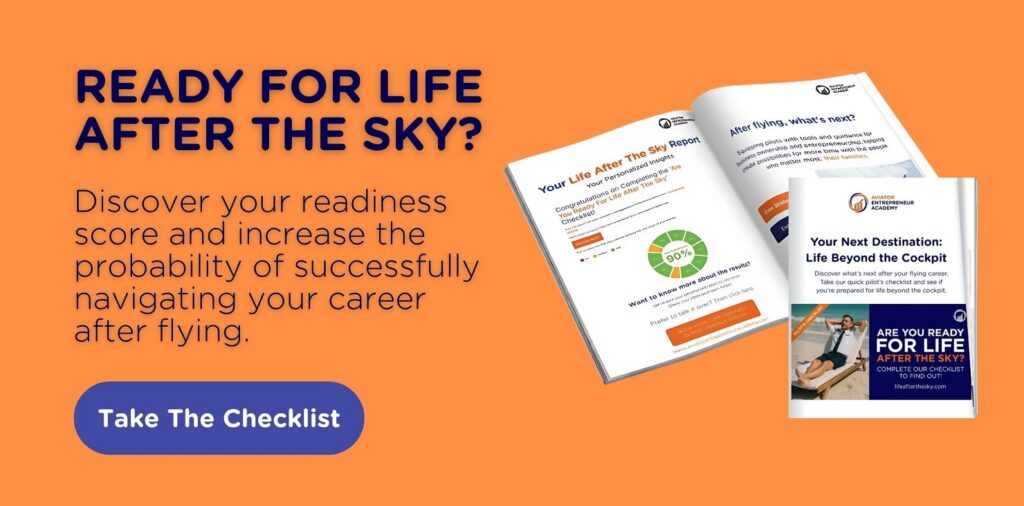Your salary may feel secure, but deep down, you know it’s fragile.
One contract change, a medical issue, or an airline restructuring could ground your income overnight. Pilots work hard, yet many are caught in the same trap: trading more hours in the sky for more dollars.
The problem? Salary is like fuel. It burns fast, keeps you moving, but once it’s gone, you’re left with nothing to carry you forward.
But what if you owned the aircraft?
Here, the aircraft means assets that help you stay afloat. And it’s not that difficult to build. Let’s understand how.
Key Takeaways: The Four Asset Classes
- Real Estate: Provides long-term stability, consistent cash flow, and protection against inflation. Ideal for pilots looking for steady, tangible income.
- Business Ownership: Offers high growth potential and control. Leverages your aviation expertise to create scalable, income-generating ventures.
- Financial Securities: Easy to manage, liquid, and diversified. Systematic investing in stocks, bonds, and index funds builds long-term wealth.
- Intellectual Property: Unlocks exponential, global income potential. Turn your aviation knowledge into courses, content, or digital products that earn while you sleep.

The Four Asset Classes That Matter
When you understand the career comfort trap, you know what you need to do to build wealth that lasts. With the right mix in your portfolio, you can build something that survives the turbulence. Something that carries you beyond your last flight.
1. Real Estate: The Commercial Airliner of Assets
Real estate has long been the backbone of wealth for many who want both stability and growth. Over the past 25 years, private commercial real estate has averaged ≈10.3% annually in the U.S., slightly outpacing the S&P 500, which has been about 9.6% in the same period.
Even in weaker decades, private real estate has never produced a 10-year annualized return below ≈4%–6%.
2. Business Ownership: The Fighter Jet of Assets
Business ownership carries more risk, but also more control and upside. The returns can vary wildly, but founders and owners often see returns far above what passive investments deliver with effort and smart planning.
Small businesses deliver returns of 50% or more in their early high-growth years, although the risk is high.
3. Financial Securities: The Training Aircraft of Assets
Securities are like a training aircraft. They are stable, predictable, and easier to manage than other assets. This category includes stocks, bonds, ETFs, and index funds.
The S&P 500, which tracks 500 of the largest U.S. companies, has averaged about 10% annual returns for decades, including dividends. That consistency is why most financial planners recommend index funds as a core holding.
4. Intellectual Property: The Experimental Aircraft of Assets
This is the most creative category, yet also the one with the most unlimited potential. Intellectual property (IP) is anything you create that can be sold or licensed, such as content, courses, software, or even apps.
Unlike real estate or stocks, the upside here is not capped. You could build something once and earn from it for years.
Practical Strategies for Each Asset Class
Here are the practical strategies you can use to grow your wealth in each asset class:
1. Real Estate
The first step is to optimize your primary residence, which is close to your crew bases or near airports you fly out of frequently. That lower commute saves money and stress.
If possible, but in an area with strong rental demand. That way, even if you move bases, you can rent out the house. You can use local real estate networks to find trustworthy property managers.
Consider international real estate only if you understand local laws, currency risk, and tax implications. Maybe one property in a second country you’re familiar with (layovers, past trips).
Here’s a guideline many real estate investors use (adapted for pilots):
| Element | What to Aim For |
| Down Payment | 20-25% down lowers your loan burden and monthly payments. You’ll need savings. |
| Rent-to-Purchase Price Ratio | Try to get a monthly rent of ~1% of the purchase price. For example, if the property costs $200,000, the rent should be $2,000/month. |
| Cash Flow After Costs | After accounting for mortgage, taxes, insurance, upkeep, and property management fees, ensure you still have a positive cash flow. |
| Appreciation Estimate | Consider local growth, including jobs, infrastructure, and population growth. Target markets with an expected 5-10% annual growth. |
2. Business Development
In business, you have a few options you can explore.
For instance, you can move towards consulting, a digital training program, or some other aviation-adjacent business.
In consulting, identify pain points in airlines/freight/logistics companies. Then use your flight experience to solve them. You can also offer remote consulting, so time zones and location don’t hurt you.
Additionally, online courses for aspiring pilots are another business opportunity. If you publish even a small course, you can later update it, automate sales, and scale globally. Create short training videos and utilize platforms like Udemy to sell them.
3. Investment Portfolio
Investment isn’t as simple as investing in real estate. There are multiple avenues that you need to cover to find the right way to grow your portfolio. Here are a few things you should know:
a) Recommended Allocation Percentages
Not sure where to begin? This is the allocation that many diversified inventors use. You can adjust it based on how risk-tolerant you are:
- ~40% in stock index funds (global & domestic)
- ~30% in real estate (combining your own properties, REITs, etc.)
- ~20% in business or business-adjacent assets
- ~10% in alternative assets or intellectual property
This mix gives you growth (stocks), stability/inflation hedge (real estate), upside (business), and leveraged/geographic benefit (IP or alt assets).
b) Dollar-Cost Averaging System Aligned with Flight Schedules
Set up automatic investments every pay period (monthly or even every time you’re paid). Even if amounts are small, consistency is powerful.
Studies show that while lump-sum investment often outperforms dollar-cost averaging (because money is in the market longer), DCA helps reduce emotional risk and avoids timing the market wrong.
Make sure to use DCA, especially when markets are volatile or when you want to risk putting in a large sum just before a market drop.
4. Intellectual Property Development
To grow intellectual property, pick topics you know well. It could be aviation safety, crew lifestyle, or even flight logs. Your experience is unique, and by combining it with simple equipment, you can monetize it via ads, memberships, and more.
Moreover, you can build structured courses around what you teach or know. Make use of platforms that handle payments, hosting, and student communication, so you don’t have to do all of it manually.
This asset class is all about sharing your experience with the world. This will help you build authority in your niche and open doors for other businesses.
Take Control of Your Financial Flight Path
You’ve learned how you can build wealth that works while you fly. However, knowledge alone isn’t enough.
The real question is simple: are you ready to turn this plan into action?
If you want clarity, the Life After the Sky checklist is specifically designed for that purpose. In under 3 minutes, it helps you understand how prepared you are, identify your priorities, and see the first actionable steps to secure your future.
This is where you should start.
Invitation to Join our FREE Strategy Session
Most pilots are one honest conversation away from clarity. This is that conversation.
Complete our “Life After the Sky” checklist, then join me for a FREE 15-minute “Strategy Session” via Zoom.
This session has been created for pilots who want to take ownership of what comes next.
Those who want action, not just to talk about it.
In just 15 minutes, we’ll:
- Review your checklist results
- Identify the one obstacle holding back your reinvention
- Translate your checklist results into a clear starting point
Start your pre-flight assessment for the next chapter of your journey by Booking your free strategy session here!



